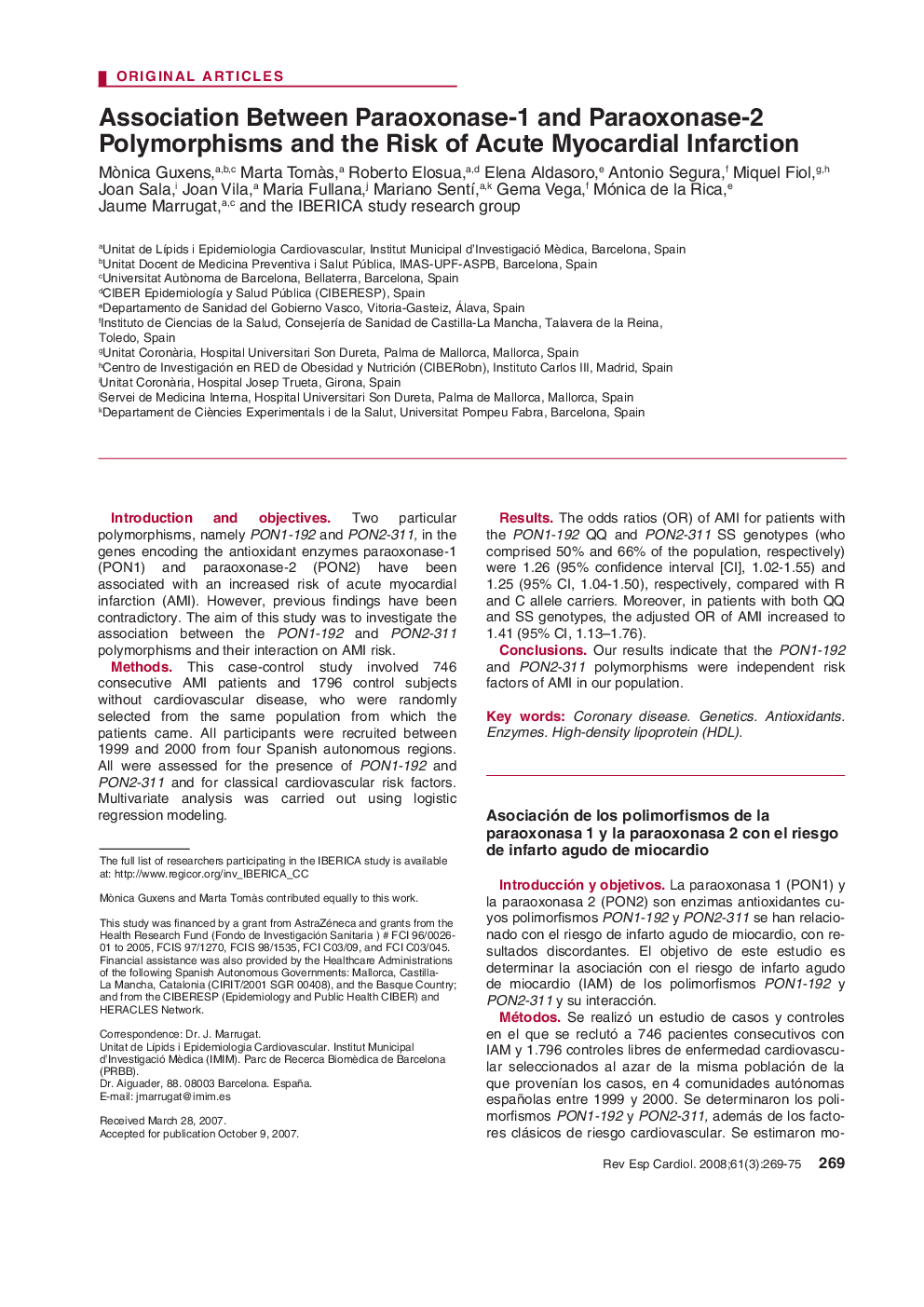| کد مقاله | کد نشریه | سال انتشار | مقاله انگلیسی | نسخه تمام متن |
|---|---|---|---|---|
| 3018907 | 1182188 | 2008 | 7 صفحه PDF | دانلود رایگان |

Introduction and objectivesTwo particular polymorphisms, namely PON1-192 and PON2-311, in the genes encoding the antioxidant enzymes paraoxonase-1 (PON1) and paraoxonase-2 (PON2) have been associated with an increased risk of acute myocardial infarction (AMI). However, previous findings have been contradictory. The aim of this study was to investigate the association between the PON1-192 and PON2-311 polymorphisms and their interaction on AMI risk.MethodsThis case-control study involved 746 consecutive AMI patients and 1796 control subjects without cardiovascular disease, who were randomly selected from the same population from which the patients came. All participants were recruited between 1999 and 2000 from four Spanish autonomous regions. All were assessed for the presence of PON1-192 and PON2-311 and for classical cardiovascular risk factors. Multivariate analysis was carried out using logistic regression modeling.ResultsThe odds ratios (OR) of AMI for patients with the PON1-192 QQ and PON2-311 SS genotypes (who comprised 50% and 66% of the population, respectively) were 1.26 (95% confidence interval [Cl], 1.02-1.55) and 1.25 (95% Cl, 1.04-1.50), respectively, compared with R and C allele carriers. Moreover, in patients with both QQ and SS genotypes, the adjusted OR of AMI increased to 1.41 (95% Cl, 1.13-1.76).ConclusionesOur results indicate that the PON1-192 and PON2-311 polymorphisms were independent risk factors of AMI in our population.
Introducción y objetivosLa paraoxonasa 1 (PON1) y la paraoxonasa 2 (PON2) son enzimas antioxidantes cuyos polimorfismos PON1-192y PON2-311 se han relacionado con el riesgo de infarto agudo de miocardio, con resultados discordantes. El objetivo de este estudio es determinar la asociación con el riesgo de infarto agudo de miocardio (IAM) de los polimorfismos PON1-192 y PON2-311 y su interacción.MétodosSe realizó un estudio de casos y controles en el que se reclutó a 746 pacientes consecutivos con IAM y 1.796 controles libres de enfermedad cardiovascular seleccionados al azar de la misma población de la que provenían los casos, en 4 comunidades autónomas españolas entre 1999 y 2000. Se determinaron los polimorfismos PON1-192y PON2-311, además de los factores clásicos de riesgo cardiovascular. Se estimaron modelos de regresión logística para los análisis multivaribles.ResultadosLas odds ratio (OR) del genotipo QQ del polimorfismo PON1-192y el SS del PON2-311 (presentes en el 50 y el 66% de la poblacion, respectivamente) de presentar un IAM fueron 1,26 (intervalo de confianza [IC] del 95%, 1,02-1,55) y 1,25 (IC del 95%, 1,04-1,50), respectivamente, en comparacion con los portadores de los alelos R y C. Además, para los sujetos que presentan ambos genotipos QQ y SS, la OR ajustada de tener un IAM se incrementó hasta 1,41 (IC del 95%, 1,13-1,76).ConclusionsNuestros resultados indican que los polimorfismos PON1-192 y PON2-311 son factores de riesgo de IAM independientes en nuestra poblacion.
Journal: Revista Española de Cardiología (English Edition) - Volume 61, Issue 3, 2008, Pages 269-275